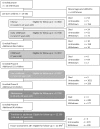Cohort Profile: the 'children of the 90s'--the index offspring of the Avon Longitudinal Study of Parents and Children
- PMID: 22507743
- PMCID: PMC3600618
- DOI: 10.1093/ije/dys064
Cohort Profile: the 'children of the 90s'--the index offspring of the Avon Longitudinal Study of Parents and Children
Abstract
The Avon Longitudinal Study of Parents and Children (ALSPAC) is a transgenerational prospective observational study investigating influences on health and development across the life course. It considers multiple genetic, epigenetic, biological, psychological, social and other environmental exposures in relation to a similarly diverse range of health, social and developmental outcomes. Recruitment sought to enroll pregnant women in the Bristol area of the UK during 1990-92; this was extended to include additional children eligible using the original enrollment definition up to the age of 18 years. The children from 14541 pregnancies were recruited in 1990-92, increasing to 15247 pregnancies by the age of 18 years. This cohort profile describes the index children of these pregnancies. Follow-up includes 59 questionnaires (4 weeks-18 years of age) and 9 clinical assessment visits (7-17 years of age). The resource comprises a wide range of phenotypic and environmental measures in addition to biological samples, genetic (DNA on 11343 children, genome-wide data on 8365 children, complete genome sequencing on 2000 children) and epigenetic (methylation sampling on 1000 children) information and linkage to health and administrative records. Data access is described in this article and is currently set up as a supported access resource. To date, over 700 peer-reviewed articles have been published using ALSPAC data.
Figures







Comment in
-
Autism genes: the continuum that connects us all.J Genet. 2016 Sep;95(3):481-3. doi: 10.1007/s12041-016-0688-0. J Genet. 2016. PMID: 27659318 No abstract available.
References
-
- Golding J. Research protocol. European Longitudinal Study of Pregnancy and Childhood (ELSPAC) Paediatr Perinat Epidemiol. 1989;3:460–69. - PubMed
-
- The ELSPAC website. http://ivdmr.fss.muni.cz/english/view.php?cisloclanku=2005050401 (29 February 2012, date last accessed)
-
- ALSPAC Funders. http://www.bristol.ac.uk/alspac/participants/ethics/funding/ (29 February 2012, date last accessed)
-
- Boyd A, Golding J, Macleod JAA. Scottish Health Informatics Programme (SHIP) Bi-annual Conference. UK: St. Andrews; 2011. Using linkage to health and social administrative records to quantify the response rate to initial recruitment in the Avon Longitudinal Study of Parents and Children (ALSPAC) and assess possible bias associated with non-response (Abstract)
Publication types
MeSH terms
Grants and funding
LinkOut - more resources
Full Text Sources
Other Literature Sources
Medical

